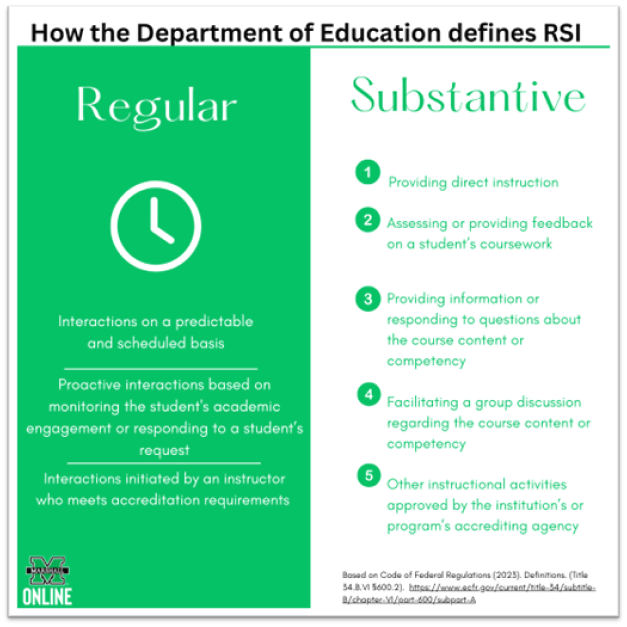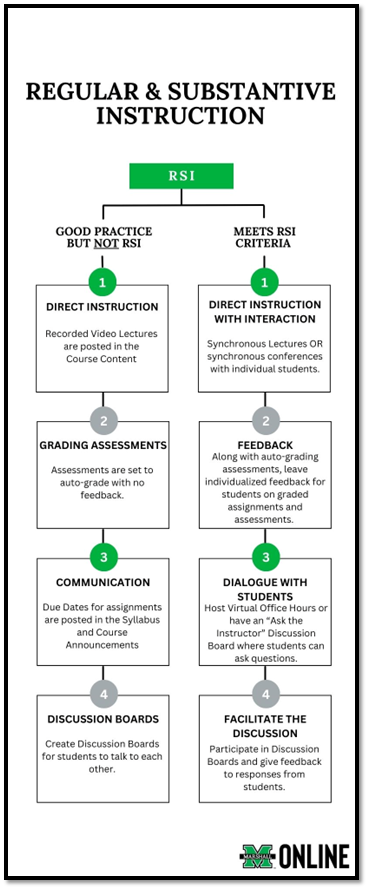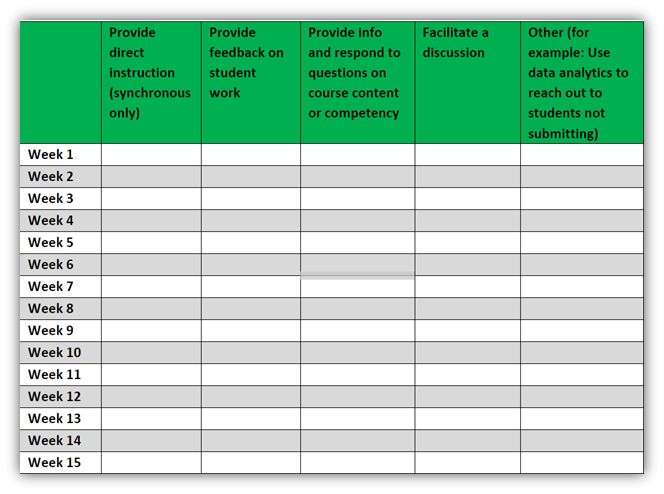Regular and Substantive Interaction (RSI)
To have a good learning experience in online courses, students need lots of opportunities for interaction—with their peers, with the content, and with their instructor. While it is important to include a variety of interactive activities, not all of these count as “Regular and Substantive Interaction” (RSI) as defined by the U.S. Department of Education.

The Regulations
The Code of Federal Regulations defining distance education, updated in July 2021, reflects the required federal benchmark of instructor-student interaction that separates a correspondence course from a distance course (34 CFR 600.2 “Distance education”). This is a crucial difference since this determination has implications for federal financial aid to the institution, meaning that federal audits to review institutional adherence to RSI can have institutional consequences (Piña and Martindale, 2023).
Beyond the Regulations
While it is important to note this benchmark, online faculty know that developing opportunities for instructor-student interactions can have significant benefits for their students, since “instructor-student relationships are the connective tissue between students, engagement, and rigor” (Pecansky-Brock et al., 2020). We show you how to meet and exceed RSI standards, a tool to reflect on RSI in your classes, and how instructional designers can support you in RSI design.
Meeting RSI Standards
The Department of Education defines substantive interaction as “engaging students in teaching, learning, and assessment, consistent with the content under discussion, and also includes at least two of the following”:
(i) Providing direct instruction;
(ii) Assessing or providing feedback on a student’s coursework;
(iii) Providing information or responding to questions about the content of a course or competency;
(iv) Facilitating a group discussion regarding the content of a course or competency; or
(v) Other instructional activities approved by the institution’s or program’s accrediting agency.
The Department of Education defines regular interaction as:
(i) Providing the opportunity for substantive interactions with the student on a predictable and scheduled basis commensurate with the length of time and the amount of content in the course or competency; and
(ii) Monitoring the student’s academic engagement and success and ensuring that an instructor is responsible for promptly and proactively engaging in substantive interaction with the student when needed on the basis of such monitoring, or upon request by the student. (34 CFR 600.2 “Distance education”)
RSI Goes Beyond Good Practice
While some activities are good practice, they may not fall under RSI:
Exceeding RSI Standards
RSI aligns with common best practices for both design and delivery in online learning, such as building instructor presence, communicating the instructor’s “plan for regular and substantive interaction,” and adaptive teaching – using data to identify high-opportunity students (QM; Pecansky-Brock et al., 2020). In addition, regular instructor-student interaction supports Marshall’s strategic plan for student experience and success because of its impact on belongingness (Strategic Plan; Belongingness).
Take RSI from standard to the next level:
- Post an instructor welcome video to introduce the course
-
- Level up: Create a discussion board where students can introduce themselves and what they hope to gain from the class via video (using Panopto or Flip)
- Facilitate regular discussions
-
- Level up: Use Panopto to facilitate discussions with video or encourage students to include multimedia, such as images or gifs.
- Provide regular written feedback
-
- Level up: Add frequently used comments to the grading Content Library to free you up for more individualized higher-order feedback; consider using Flexible Grading to provide audio or video feedback
- Monitor and respond to an open Q&A discussion board
-
- Level up: Use the Allow Conversations tool to encourage more specific Q&A on assignments
- Record video lectures and tie them to an assessment with feedback
-
- Level up: Embed self-checks within the video lecture to help students self-assess
- Give feedback on individual student progress
-
- Level up: Provide optional opportunities for synchronous conferences to discuss work in progress
- Send out an end-of-semester survey asking students to share what interactions helped and what suggestions they have
-
- Level up: Send out a mid-term survey asking for student feedback, make appropriate changes, and communicate why you made them
- Send feedback mid-semester to mark student progress
-
- Level up: Customize Ultra’s Student Progress data to flag at-risk students and proactively reach out
RSI Self-Reflection Tool
Use the following chart as a tool to reflect on RSI design and delivery in your online course, aiming for at least one interaction a week. You can look at it next to your weekly schedule to plan for your interactions (design), or you can use it to document your interactions throughout the semester (delivery). If you have activities that are not reflected, add them at the end and connect them to at least one Substantive Criterion. Click here to open a pdf version of the RSI Self-Reflection Tool.

Instructional Designers can help with RSI!
1. Book an appointment for a one-on-one tutorial on Ultra Tools that support RSI:
- Panopto videos and student submissions
- Flexible Grading feedback (written, audio, or video feedback options)
- Allow Conversations tool
- Teams meetings and chats
2. Collaborate with a Designer on strategies to support more RSI
3. Register for Ultra Academy to learn about Ultra tools and learn from other instructors
Additional Resources
Regular and Substantive Interaction Refresh (2021): This WCET (WICHE Cooperative for Educational Technologies) article offers an overview of the updates to the regulations, comparing previous versions to new guidance based on the 2021 changes.
Letter of Response to RSI Questions (2022): This letter from the Deputy Assistant Secretary for Policy, Planning, and Innovation, responds to questions from WCET’s Director of Digital Learning, Policy & Compliance (in partnership with OLC, Quality Matters, and UPCEA) regarding RSI compliance.
Regular and Substantive Interaction Update (2022): This WCET update on the RSI conversation discusses the key takeaways from the above letter from the Department of Education, including clarification on RSI interpretation of direct instruction and office hours.
Background: Definitions of Distance Education Courses: This faculty resource from SUNY Empire State University offers a helpful chart for RSI strategies in design versus delivery of online courses.
References
Code of Federal Regulations (2023). Definitions. (Title 34.B.VI §600.2). https://www.ecfr.gov/current/title-34/subtitle-B/chapter-VI/part-600/subpart-A
Pacansky-Brock, M., Smedshammer, M., & Vincent-Layton, K. (2020). Humanizing Online Teaching to Equitize Higher Education. Current Issues in Education, 21(2). Retrieved from https://cie.asu.edu/ojs/index.php/cieatasu/article/view/1905
Piña, A., and Trey Martindale (2023). Regular and Substantive Interaction in Online Courses: Why it Matters for Administrators. The Online Journal of Distance Learning Administration, 26(2). https://ojdla.com/articles/regular-and-substantive-interaction-in-online-courses-why-it-matters-for-administrators
QM Specific Review Standards from the QM Higher Education Rubric (2023). Quality Matters. StandardsfromtheQMHigherEducationRubric.pdf (qualitymatters.org)